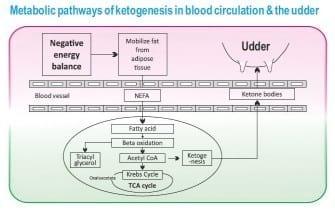Knowing the Hidden Enemy of Dairy Animals
Published: September 10, 2014
By: Dr. Zafar Ahmad & Dr. Divya Divakaran, Product Managers Natural Remedies Pvt. Ltd, Bangalore
We have travelled a long journey from backyard dairy farming to a more systematic and organized dairy farming.
An array of changes starting from improved genetic potential to better milk production and advanced management practices have made our country a stand out in the global dairy map. The famous Martin Luther King Jr. quote “All progress is precarious, and the solution of one problem brings us face to face with another problem” well suits our modern dairy farming scenario as well.
Increased milk production has brought us face to face with lesser known problems like negative energy balance (NEB), prion diseases, highly reduced immune function, auto-immune diseases etc. In this article we would like to throw some light on NEB, the hidden enemy of dairy animals. Dairy animals pass through a tough phase (transition period) every time they calve.

The transition period (period overlapping the end of late gestation and postpartum where the animal shifts from a non-Lactating and pregnant stage to a Lactating and non-Pregnant stage) is the most critical period. Rapid increases in glucose, amino acid, mineral, and fatty acid requirements occur during the transition period requiring significant adjustment in metabolism to support these needs.
 During the transition period there is a state of NEB which is critical with regards to the nutritional/energy demands. The dry matter intake (DMI) of transition cows is much lower, leading to a difference between the energy gained from feed intake and the energy spent.
During the transition period there is a state of NEB which is critical with regards to the nutritional/energy demands. The dry matter intake (DMI) of transition cows is much lower, leading to a difference between the energy gained from feed intake and the energy spent.To aggravate the NEB, process of parturition and milk production aftermath adds on to the quota of extra energy requirement. Thus it can be said that every animal walks through the path of incredible NEB during parturition.
The Consequences of NEB
It is estimated that 70-80% of diseases of dairy animals occur in the peri-parturient period (30 days prior to parturition and 70 days after parturition). NEB can be attributed to majority of these diseases due to its capacity to upset almost all of the body systems. Largely, it can be said that NEB is the hidden enemy disrupting various organ systems and causing a larger impact on the performance of dairy animals. The following are some of the consequences of NEB;
a) Fatty Liver
b) Ketosis
c) Insulin resistance
d) SARA
e) Fertility problems
f) Immuno-suppression
b) Ketosis
c) Insulin resistance
d) SARA
e) Fertility problems
f) Immuno-suppression
a) Fatty Liver
In the early-lactation cow, reduction of dry matter intake as well as the associated stress around calving will increase the Non-esterified fatty acids (NEFA) in the blood. NEFA are transported to liver from all the lipid stores of body to produce ketone bodies or acetate in turn to be utilized for milk fat synthesis, peripheral tissues for energy & re-esterification of triglycerides by the liver. Unfortunately for cows, fatty accumulation in the liver is a very common sequel due to excessive accumulation of triglycerides and slow export of the same as they have limited capacity to produce apo-protein B, a compound necessary for exportation of fats.
b) Ketosis
Ketosis is a metabolic disease which is very often observed in high producing animals. It is associated with poor management during the transition period resulting in decreased dry matter intake and increased BCS loss. Ketosis is characterized by prolonged hypoglycemia with high blood ketones including acetate, acetoacetate & β–hydroxy butyrate. If ketosis remains undiagnosed and proper therapeutic and nutritional interventions aren’t made, it may result in protein catabolism and severe loss of body condition with debility.
prolonged hypoglycemia with high blood ketones including acetate, acetoacetate & β–hydroxy butyrate. If ketosis remains undiagnosed and proper therapeutic and nutritional interventions aren’t made, it may result in protein catabolism and severe loss of body condition with debility.
 prolonged hypoglycemia with high blood ketones including acetate, acetoacetate & β–hydroxy butyrate. If ketosis remains undiagnosed and proper therapeutic and nutritional interventions aren’t made, it may result in protein catabolism and severe loss of body condition with debility.
prolonged hypoglycemia with high blood ketones including acetate, acetoacetate & β–hydroxy butyrate. If ketosis remains undiagnosed and proper therapeutic and nutritional interventions aren’t made, it may result in protein catabolism and severe loss of body condition with debility.c) Insulin Resistance
Higher concentration of NEFA results in the formation of TNF-α (Tumor necrosis factor-α) which in turn causes Insulin resistance in cattle. Insulin resistance decreases the sensitivity to metabolic actions of Insulin, such as Insulin-mediated glucose disposal and inhibition of hepatic glucose production. In simple terms Insulin resistance causes decrease in gluconeogenic capacity. If the liver has decreased ability to make glucose to support milk production, this further extends the amount of lipolysis which must occur in order to support lactation.
d) Sub-acute ruminal acidosis (SARA)
SARA is a disorder of ruminal fermentation characterized by extended periods of depressed ruminal pH (> 5.5). This drop in ruminal pH occurs at calving when dry cows are abruptly switched from high fibre diets to higher concentrate milking cow diets. Another cause of SARA can be attributed to improperly balanced rations or the smaller particle size of the feed since this suppresses rumination and saliva production and hence buffer changes in ruminal pH.
e) Fertility Problems
 NEB in early lactation is the largest contributor to nutritionally related reproductive challenges in the dairy cow. The net result of this problem is prolonged calving to conception intervals and greater probability of culling due to reproductive failure. NEB can exert its effect on reproductive efficiency through several different ways. One way is through impaired GnRH secretion from the hypothalamus leading to inadequate LH release from the anterior pituitary which either leads to poor follicular growth and atresia or development of follicular cysts. Another way is by NEB effect on follicular steroidogenesis of granulosa cells in Corpus luteum. Impaired steroidogenesis further depresses the progesterone levels and impairs fertility.
NEB in early lactation is the largest contributor to nutritionally related reproductive challenges in the dairy cow. The net result of this problem is prolonged calving to conception intervals and greater probability of culling due to reproductive failure. NEB can exert its effect on reproductive efficiency through several different ways. One way is through impaired GnRH secretion from the hypothalamus leading to inadequate LH release from the anterior pituitary which either leads to poor follicular growth and atresia or development of follicular cysts. Another way is by NEB effect on follicular steroidogenesis of granulosa cells in Corpus luteum. Impaired steroidogenesis further depresses the progesterone levels and impairs fertility.f) Immuno-suppression
NEB effect on immuno-suppression is by far less understood but many research findings hint that NEB has definitive impact on the immunity levels of the animals. Research to date suggests that this immune dysfunction appears to be due to combination of endocrine and metabolic factors. Thus immuno-suppression is an indirect effect of NEB exerted through disruptions in other functions of the dairy animals. Depressed immunity can result in decreased production efficiency and increased incidences and severity of infections in transition period.
Management of NEB in Transition Period
The action needs to be initiated at farmer level through proper extension and education activities showing the importance of various management practices around the transition period. One such practice is by maintaining energy intake throughout the pre-partum period till calving and increasing intake rapidly thereafter since this reduces the impact of NEB and its detrimental effects on coordinated ovarian and liver functions. Another practice is by management of feed intake, overall nutritional balance, and metabolic health in the transition period till early lactation. Finally a significant management practice of Propylene glycol administration during close-up period and immediately after calving has a positive impact on reducing the incidences of NEB related disorders. Timely and proper interventions as aforementioned ones help us to achieve the ultimate goal of a commercial dairy farm with production of high quality milk, high productivity & healthy herd.
Related topics
Authors:
Join to be able to comment.
Once you join Engormix, you will be able to participate in all content and forums.
* Required information
Would you like to discuss another topic? Create a new post to engage with experts in the community.
Create a post
11 de septiembre de 2014
Very informative article..full of insights..look forward to more such articles





